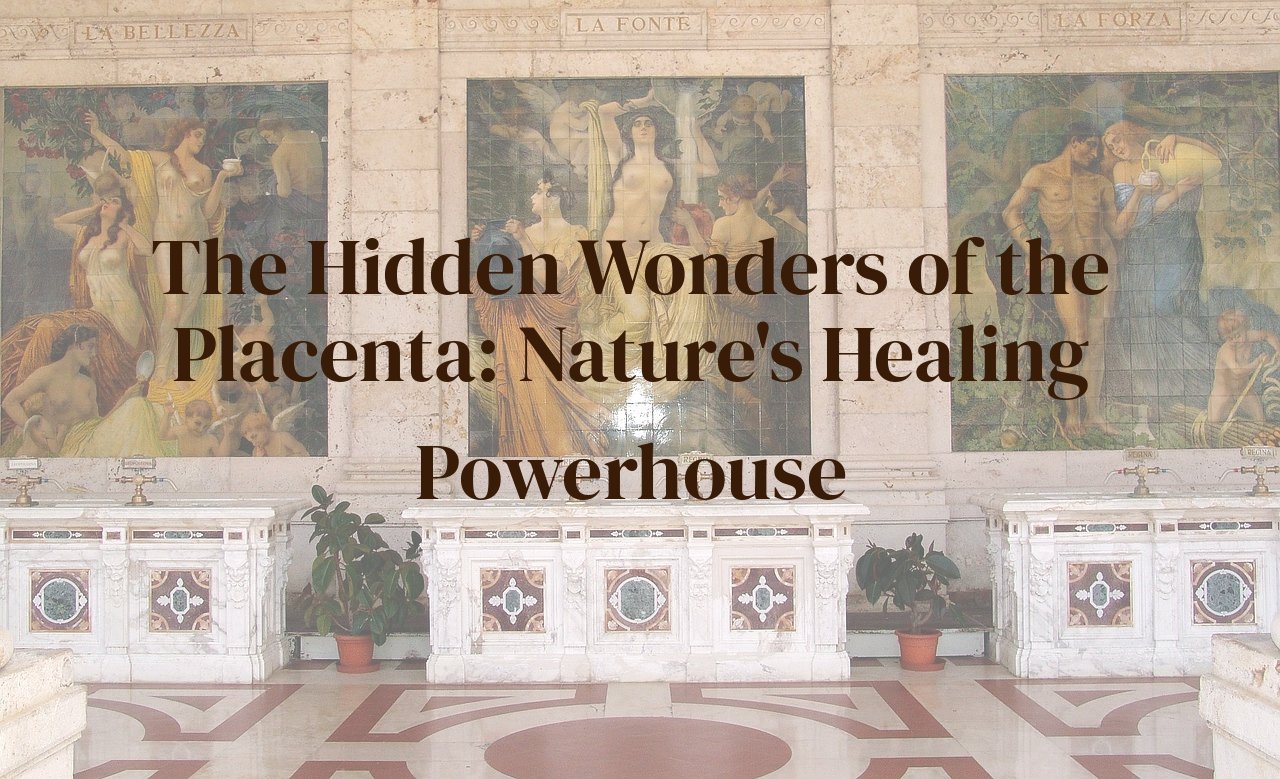
In the realm of healthcare and medicine, certain organs often overshadow others in discussions of health and healing. One such overlooked gem is the placenta. This blog post delves into the remarkable healing properties of the placenta, exploring how this vital organ is more than just a temporary lifeline for a developing fetus.
By reading this post, you will uncover intriguing insights about the placenta’s functions and its potential applications in modern medicine. Whether you are a medical professional, a health enthusiast, or someone curious about natural healing, the information provided here can broaden your knowledge and perhaps even inspire new perspectives on health and wellness.
Table of Contents
A Deep Dive into Placenta Anatomy and Function
The placenta is truly a marvel of nature, often referred to as the ‘tree of life’ due to its essential functions in pregnancy. This unique, temporary organ forms in a woman’s uterus during pregnancy, establishing a vital lifeline between mother and fetus. Its structure is complex, intricate, and indispensable for the survival and health of both the mother and the growing baby.
Anatomically, the placenta is disc-shaped and composed of several layers and parts. One of the most critical components is the chorionic villi, finger-like projections that extend into the uterine wall. These villi facilitate the exchange of nutrients and gases between mother and fetus. Each villus contains a network of fetal blood vessels that are surrounded by maternal blood, allowing for the efficient transfer of oxygen, carbon dioxide, and nutrients.
The umbilical cord, another significant feature, connects the fetus to the placenta. Inside the cord are two arteries and one vein encased in a gelatinous substance called Wharton’s jelly. The arteries carry deoxygenated blood and waste products from the fetus to the placenta, while the vein delivers oxygen-rich blood and nutrients back to the fetus. This vascular system is a testament to the placenta’s role in sustaining and nurturing life.
On the maternal side, the basal plate lies in contact with the uterine wall. It contains various cell types, such as cytotrophoblasts and syncytiotrophoblasts, which play crucial roles in embedding the placenta into the uterine lining and facilitating nutrient exchange. These cells produce hormone signals like human chorionic gonadotropin (hCG), progesterone, and estrogen, which regulate pregnancy and support fetal development.
Interestingly, the placenta also acts as a sentinel, protecting the fetus from potential threats. It serves as an immunological barrier, preventing the mother’s immune system from attacking the fetus, which is genetically distinct from her. This immune-modulating function is vital for the success of the pregnancy.
Reflecting on my own experiences as a health professional, I am continuously in awe of the placenta’s adaptive capabilities. When attending childbirth and observing the delivery of the placenta, I am reminded of its sheer power and complexity. Each time, I bear witness to the culmination of months of silent work, supporting two intertwined lives.
Ultimately, the placenta is not merely an intermediary but a dynamic organ with multiple and sophisticated roles. Understanding its anatomy and function deepens our appreciation of its extraordinary significance in human reproduction and opens the door to exploring its potential in healing and therapeutic contexts.
Historical Uses of the Placenta in Medicine
Throughout human history, the placenta has been revered and utilized in various cultures for its purported healing properties. While modern medicine often overlooks this organ, traditional practices have long celebrated its unique benefits.
In ancient China, the placenta, known as ‘Zi He Che’, was widely used in traditional Chinese medicine. Believed to invigorate the body’s vital energy or ‘qi’, it was dried, ground into a powder, and ingested to boost recovery and strength. Anecdotal records also suggest its use for treating infertility and enhancing lactation.
Practices in Western cultures date back to at least the Classical Era. Historical texts reveal that the Ancient Greeks valued the placenta for its reputed ability to aid in childbirth recovery. It was often prepared as a broth or stew, believed to rejuvenate and replenish a mother’s strength postpartum.
In Africa, among certain Indigenous tribes, the placenta was not only buried as part of spiritual rituals but also consumed in ceremonies aimed at granting protection and health for the newborn. The Maasai tribe, for instance, considered the placenta sacred and used it in medicinal practices to ward off disease and ensure longevity.
The Mayan civilization in Central America also held the placenta in high regard. Women consumed parts of it to foster a smoother postnatal recovery and to gain strength. It was thought to harbor the vital essence of both mother and child, making it an essential element in their traditional healing practices.
In Europe, during the Middle Ages, there are records indicating the placenta was sometimes used in concoctions believed to cure various ailments. Healers would mix it with herbs and other natural substances to create potions that were thought to possess powerful restorative qualities.
One of my personal experiences as a health blogger was attending a traditional medicine seminar where a practitioner demonstrated various ways the placenta was historically used. It was fascinating to witness how deeply it was embedded in healing practices across different cultures. This reinforced my belief in the importance of exploring historical medicinal uses to better understand the potential contemporary applications of the placenta.
Modern Scientific Research on Placenta-Based Therapies
The field of modern medicine is continuously evolving, and one area that has garnered significant attention is placenta-based therapies. Once overlooked, the placenta has now emerged as a promising resource in the quest for innovative treatments. The scientific community has been exploring its vast potential, and the results are nothing short of extraordinary.
One of the most fascinating aspects of modern research into placenta-based therapies is its application in regenerative medicine. Scientists have discovered that the placenta is a rich source of stem cells, which have the remarkable ability to differentiate into various cell types. This has opened up new possibilities in treating conditions such as spinal cord injuries, heart diseases, and neurodegenerative disorders. Researchers are particularly excited about the placenta’s potential to regenerate damaged tissues and organs, offering hope to patients with previously untreatable conditions.
Another promising area of research is the use of placental extracts for their anti-inflammatory and immunomodulatory properties. Studies have shown that the placenta contains a wealth of bioactive compounds, including growth factors, cytokines, and hormones, which can modulate the immune response and reduce inflammation. This has significant implications for conditions such as autoimmune diseases, chronic inflammatory disorders, and even cancer. The ability of placental extracts to promote healing and reduce inflammation has led to their use in various clinical settings, from wound healing to enhancing skin health.
Beyond its regenerative and anti-inflammatory properties, the placenta is also being investigated for its potential in enhancing fertility treatments. Researchers have found that placental-derived compounds can improve the success rates of in vitro fertilization (IVF) and other assisted reproductive technologies. The growth factors and hormones present in the placenta can support embryo development and implantation, increasing the chances of a successful pregnancy for couples struggling with infertility.
Interestingly, the placenta’s benefits are not limited to physical health. Emerging research suggests that placental extracts may also have neuroprotective effects. Studies on animal models have shown that these extracts can improve cognitive function and protect against neurodegenerative diseases such as Alzheimer’s and Parkinson’s. The neuroprotective properties are believed to be due to the presence of antioxidants and other neurotrophic factors in the placenta, which support brain health and function.
While the potential of placenta-based therapies is immense, it is essential to approach this field with a balanced perspective. Ethical considerations, such as the source and use of placental tissue, and practical concerns, like the standardization and regulation of placental products, must be carefully addressed. However, the promising results thus far suggest that the placenta is far from being just a temporary organ during pregnancy—it might indeed be a hidden powerhouse of healing awaiting full harnessing by modern science.
The Benefits of Placental Nutrients and Extracts
When we delve into the benefits of placental nutrients and extracts, we enter a fascinating world where ancient wisdom meets modern science. Placenta, often referred to as ‘nature’s healing powerhouse,’ boasts an impressive array of bioactive compounds that promise a plethora of health benefits. Personally, I have always been intrigued by the notion that something so vital during pregnancy could offer life-enhancing properties long after childbirth.
The placenta is rich in growth factors such as epidermal growth factor (EGF) and transforming growth factor (TGF). EGF is particularly noteworthy for its role in skin regeneration and wound healing. I remember interviewing a dermatologist who expressed that topical treatments containing placental extracts had shown remarkable improvements in severe acne scars among her patients. TGF, on the other hand, contributes to cellular repair, making it a staple ingredient in several anti-aging products.
Also, the placenta is a treasure trove of essential nutrients, including amino acids, vitamins, and minerals. Amino acids like arginine and glycine play crucial roles in muscle growth and repair. Imagine my surprise when I learned from a fitness expert how placental supplements could potentially enhance recovery time after a strenuous workout! Moreover, the vitamins – particularly B6, B12, and folic acid – support brain function, making placenta-based supplements a potential aid in cognitive health.
One of the most captivating aspects of placental nutrients is their potential in enhancing immune function. The placenta contains cytokines, which are paramount in immune response. I had the pleasure of talking to an immunologist who suggested that placental extracts might hold the key to new treatments for autoimmune diseases. This could revolutionize the way we approach chronic illnesses, providing sufferers with an opportunity for a better quality of life.
Placental extracts are also known for their anti-inflammatory properties. These extracts can reduce inflammation in conditions like arthritis and even in skin ailments such as psoriasis and eczema. I recall a conversation with a naturopath who swore by placental-based creams for her clients with chronic skin disorders, citing significant reductions in redness and irritation.
Finally, there is the aspect of hormonal balance. The placenta produces hormones like progesterone and estrogen, which can help in regulating menstrual cycles and alleviating symptoms of menopause. A women’s health specialist I once met mentioned that placental encapsulation post-birth had provided relief for many new mothers dealing with postpartum depression and hormonal imbalances. This compelling intersection of old-world practices and new-world needs certainly struck a chord with me.
The power of the placenta is undeniable, manifesting in numerous applications that improve our health and wellbeing. By integrating these nutrients and extracts into various therapies, we stand on the frontier of medical innovation, bridging the gap between time-tested natural remedies and contemporary clinical advancements.
Ethical and Practical Considerations
When delving into the study and application of the placenta, ethical and practical considerations are paramount. One of the primary ethical dilemmas revolves around the source of the placental tissue. Most commonly, placental tissue is obtained following childbirth with the informed consent of the mother. However, the process of obtaining consent, ensuring that it is fully informed and voluntary, can be complex.
Another crucial ethical consideration is the potential for exploitation. With the rising interest in placental products, there is a risk that women in vulnerable socio-economic circumstances might be unduly pressured to donate their placentas in exchange for compensation. It is essential that regulations are in place to prevent any form of coercion or commercialization that exploits individuals.
From a practical perspective, there are several factors to consider when handling and processing placental tissue. Proper hygiene and storage are critical to prevent contamination and maintain the integrity of the samples. The placenta should be collected in a sterile environment and processed swiftly. The cold chain must be maintained to preserve the biological activity of the placental extracts.
Moreover, the use of placental products brings forth regulatory challenges. Different countries have varying regulations regarding the use and distribution of placental tissues. Navigating these regulations can be difficult for researchers and healthcare providers. It is crucial to stay updated with local and international guidelines to ensure compliance and safety.
Personal experience has taught me the importance of ongoing education and conversation with patients about these therapies. Transparency is key. For instance, I always ensure that my patients understand the benefits and risks associated with placental-based treatments. This not only helps in building trust but also empowers them to make informed decisions about their health.
Overall, while the potential benefits of placental therapies are significant, navigating the ethical and practical challenges is necessary to harness its full potential responsibly and ethically.
Conclusion
The placenta, often relegated to the realms of pregnancy and childbirth, holds an astonishing array of healing properties that can revolutionize modern medicine. By understanding and harnessing these properties, we stand at the threshold of new, transformative healthcare solutions.
May this exploration of the placenta’s potential ignite your curiosity and inspire innovative thoughts in the fields of health and medicine. Embrace the hidden wonders of nature and let them guide you towards better well-being.



